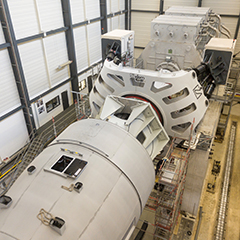Alliance investigates validation of test methodologies
The CertBench project is now entering phase two: Further research work and an array of experimental tests are planned in order to establish the requirements for certifying the electrical properties of wind turbines on system test benches: The nacelle of a 3 MW turbine from project partner ENERCON will undergo tests as per the guidelines relevant for certification in the Dynamic Nacelle Testing Laboratory (DyNaLab). Realistic loads and interactions between the nacelle and rotor will be simulated using real-time models and control algorithms on the test bench for hardware-in-the-loop (HiL) operation. The test methods can be validated by comparing the results of the tests with the field data. Accelerated testing under laboratory conditions has the potential to make it significantly easier for manufacturers to plan the market launch of new and modified tur- bine models.
Within the scope of this subproject to validate test benches, an ENERCON nacelle has been set up on the Fraunhofer IWES test bench in Bremerhaven. Following the first suc- cessful pre-tests according to TR3 and successful testing of HiL test bench operation, this project can now get started properly. The aim is to demonstrate that the grid-side loads can be realistically simulated by the virtual 36,000 V medium-voltage grid in the Fraun- hofer DyNaLab. If this were the case, it would be possible to determine the electrical properties of a wind turbine on a test bench with the same degree of reliability as in the field.
Until now, measurement data from field tests have been used to certify new wind tur- bine types. As part of the CertBench project, the alliance partners aim to prove that typical network faults such as UVRT- and OVRT-Events can be reproduced just as realisti- cally on a system test bench. In an emulated grid, certain faults can be generated as often as required and “at the touch of a button”. This, in turn, means the certification requirements can be tested in a time-effective and well-planned manner.


























